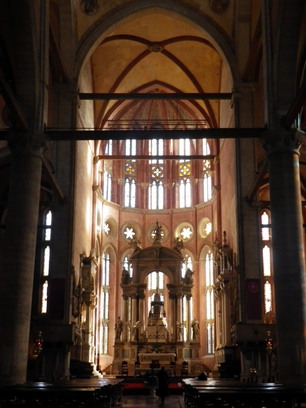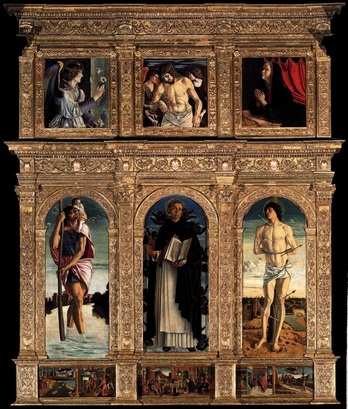Santi Giovanni e Paolo
Open: 9-18. Holidays: 12-18. (€2.50).
Map.
Map.

The great Gothic church of Santi Giovanni e Paolo (which is known in Venetian dialect as San Zanipolo), was built for the Dominican order between 1333 and 1430. Its façade was never completed. The church, the largest in Venice, takes the form of a Latin cross with a nave and two side aisles. The well-lit and lofty nave leads to an apse pierced by two tiers of slender windows with trefoil arches.
The walls of San Zanipolo are lined with the tombs of numerous doges and leading members of the city's patrician families. The counter-façade commemorates three doges, who were all members of the Mocenigo family. Their three monuments, the work of the Lombardo family of sculptors, take up almost the entire wall.
Perhaps the most unusual monument in San Zanipolo is that of Marcantonio Bragadin. In 1569 Bragadin was appointed Captain-General of Famagusta in Cyprus, which had been colonised by the Venetian state. A year after his appointment an army of the Ottoman empire laid siege to the city. Under Bragadin's leadership, Famagusta held out for almost a year. When the city finally surrendered, its captain-general was first tortured and then flayed alive. The urn, which makes up part of his monument, is said to contain Bragadin's skin.
To the left of the monument is a fine altarpiece by Giovanni Bellini. The polyptych was commisioned by the St Vincent Ferrer confraternity in the 1460s.
The Chapel of the Rosary (which can be found at the end of the left aisle) was the seat of the Scuola del Rosario, which was founded in 1575 to mark the naval victory over the Turkish fleet at the Battle of Lepanto on October 7th, 1571. The battle had been won on the Feast Day of the Rosary and, so it was believed by the victors, through the support of the Madonna of the Rosary, hence the chapel's dedication.
There is a bronze statue of Sebastian Venier, one of the Venetian heroes of the battle, outside the entrance to the chapel. As the victory was enormously significant for the Venetians, no expense was spared in the decoration of the chapel. However, much of this was lost when a fire broke on August 16th, 1867. The splendid paintings by Veronese, which now adorn the chapel, were transferred here from the church of the Umiliati.
The walls of San Zanipolo are lined with the tombs of numerous doges and leading members of the city's patrician families. The counter-façade commemorates three doges, who were all members of the Mocenigo family. Their three monuments, the work of the Lombardo family of sculptors, take up almost the entire wall.
Perhaps the most unusual monument in San Zanipolo is that of Marcantonio Bragadin. In 1569 Bragadin was appointed Captain-General of Famagusta in Cyprus, which had been colonised by the Venetian state. A year after his appointment an army of the Ottoman empire laid siege to the city. Under Bragadin's leadership, Famagusta held out for almost a year. When the city finally surrendered, its captain-general was first tortured and then flayed alive. The urn, which makes up part of his monument, is said to contain Bragadin's skin.
To the left of the monument is a fine altarpiece by Giovanni Bellini. The polyptych was commisioned by the St Vincent Ferrer confraternity in the 1460s.
The Chapel of the Rosary (which can be found at the end of the left aisle) was the seat of the Scuola del Rosario, which was founded in 1575 to mark the naval victory over the Turkish fleet at the Battle of Lepanto on October 7th, 1571. The battle had been won on the Feast Day of the Rosary and, so it was believed by the victors, through the support of the Madonna of the Rosary, hence the chapel's dedication.
There is a bronze statue of Sebastian Venier, one of the Venetian heroes of the battle, outside the entrance to the chapel. As the victory was enormously significant for the Venetians, no expense was spared in the decoration of the chapel. However, much of this was lost when a fire broke on August 16th, 1867. The splendid paintings by Veronese, which now adorn the chapel, were transferred here from the church of the Umiliati.

